Estimation and Measurement of India’s Digital Economy – MeitY Report (2025)
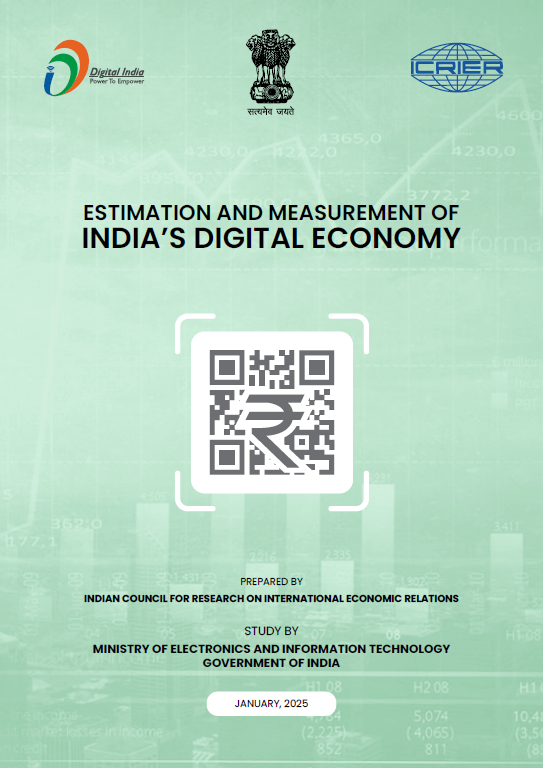
- 23 Jan 2025
In News:
Release of Report ‘Estimation and Measurement of India’s Digital Economy’ by Ministry of Electronics & Information Technology.
Key Highlights:
- Released by: Ministry of Electronics & Information Technology (MeitY)
- Prepared by: Indian Council for Research on International Economic Relations (ICRIER)
- Significance: First credible and current estimate of the digital economy using international frameworks (OECD & ADB).
- India is the first developing country to adopt the OECD framework for measuring the digital economy.
Key Findings (2022–23)
Indicator Details
Size ?31.64 lakh crore (~USD 402 billion), 11.74% of national income (GVA)
Employment 14.67 million workers (2.55% of the workforce)
Projected Share by 2029–30 Nearly 20% of GDP (surpassing agriculture & manufacturing)
Structure of India’s Digital Economy
- Digitally Enabling Industries (7.83% of GVA): ICT services, telecom, manufacturing of digital hardware
- New Digital Industries (2%): Big Tech, digital platforms, intermediaries (e.g., e-commerce, ride-sharing)
- Digitalization of Traditional Sectors (2%): BFSI (Banking, Financial Services, Insurance), trade, education
- Insight: Digital transformation is spreading beyond ICT into traditional sectors.
Frameworks Used
Framework Purpose
OECD Estimating core digital and enabling sectors
ADB Input-Output Broader economic impact via inter-industry linkages
India’s Expansion Includes digital share in BFSI, trade, education – not covered under OECD
Key Drivers of India’s Digital Economy
- Widespread mobile use: 1.14 billion subscribers in India
- High internet traffic: 3rd globally, with avg. 16.9 GB/month
- 5G leadership: 2nd largest 5G smartphone market in 2024
- Aadhaar success: 1.3+ billion biometric IDs issued
- Digital payments boom: 1,644 billion transactions in FY24
- ICT service exports: USD 162 billion (2nd highest globally)
- AI leadership: India leads GitHub AI contributions (23%)
- Startup ecosystem: 3rd highest number of unicorns globally
Future Projections (By 2030)
- Digital economy to reach ~20% of national income
- Growth drivers:
- Expansion of digital platforms & intermediaries
- Deepening digitalization in all sectors
- Greater internet & broadband access
Challenges in Measuring Digital Economy
- Difficulty in defining digital sectors due to their integrated nature
- Conventional national accounting systems are inadequate
- Lack of data from:
- Informal sector digitalization
- Smaller platforms and startups
- Digital shifts in healthcare, logistics, etc.
Importance of This Report
- Policy Formulation: Enables targeted strategies for digital growth
- Business Strategy: Helps identify trends, plan investments
- Global Standing: Puts India among early adopters of robust measurement frameworks
Mission SCOT
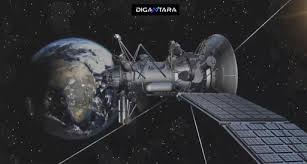
- 23 Jan 2025
In News:
The Prime Minister of India praised Indian space startup Digantara for the successful launch of Mission SCOT (Space Camera for Object Tracking) — the world’s first commercial SSA satellite, launched via SpaceX’s Transporter-12 rideshare mission.
What is Mission SCOT?
Feature Description
Developer Digantara (Indian space startup), supported by Aditya Birla Ventures & SIDBI
Launched on SpaceX Transporter-12 mission (rideshare platform)
Type First commercial Space Situational Awareness (SSA) satellite
Orbit Sun-Synchronous Orbit – ideal for consistent Earth observation
Function Tracks Resident Space Objects (RSOs) as small as 5 cm in Low Earth Orbit (LEO)
What is Space Situational Awareness (SSA)?
- SSA involves the detection, tracking, cataloging, and prediction of natural and man-made objects in Earth's orbit (like satellites, debris, etc.).
- Ensures safe and sustainable operations by minimizing collision risks.
- Critical due to increasing congestion in LEO, especially with rising numbers of small satellites and mega-constellations.
Key Features of Mission SCOT
Feature Advantage
High Revisit Rate More frequent observations of objects in orbit
Precision Tracking Can track debris ≥ 5 cm in size
All-Weather Monitoring Overcomes limitations of ground-based systems like cloud cover, FoV
Space-based System Unhindered by geography, providing continuous global surveillance
Supports SSA Infrastructure Aids in collision avoidance, space traffic management, and defence preparedness
???????? India’s SSA Ecosystem
Initiative Role
ISRO’s IS4OM Provides Indian Space Situational Assessment Report (ISSAR); enables safe & sustainable space operations
NETRA Project Network for Space Objects Tracking & Analysis – aims to build a dedicated SST (Space Surveillance & Tracking) network using radars & optical telescopes
Multi-Object Tracking Radar Operated at Sriharikota – limited range, being augmented
Collision Avoidance Manoeuvres (CAMs) Regularly performed by ISRO to protect its satellites from debris threats
Global Context: Transporter-12 Rideshare
- A SpaceX program providing low-cost access to space by allowing multiple customers to launch small payloads on a single rocket.
- Enhances global commercial space activity, democratizes space access.
Significance for India
Strategic:
- Strengthens national space defence by enabling indigenous tracking of space threats.
- Reduces reliance on foreign SSA data (e.g., NORAD/US Space Command).
Technological:
- Demonstrates India’s capability in space-based surveillance tech.
- Positions India as a global contributor in the emerging SSA domain.
Economic:
- Boosts private sector space innovation aligned with India’s NewSpace Policy.
- Attracts venture capital and international collaboration.
LID-568
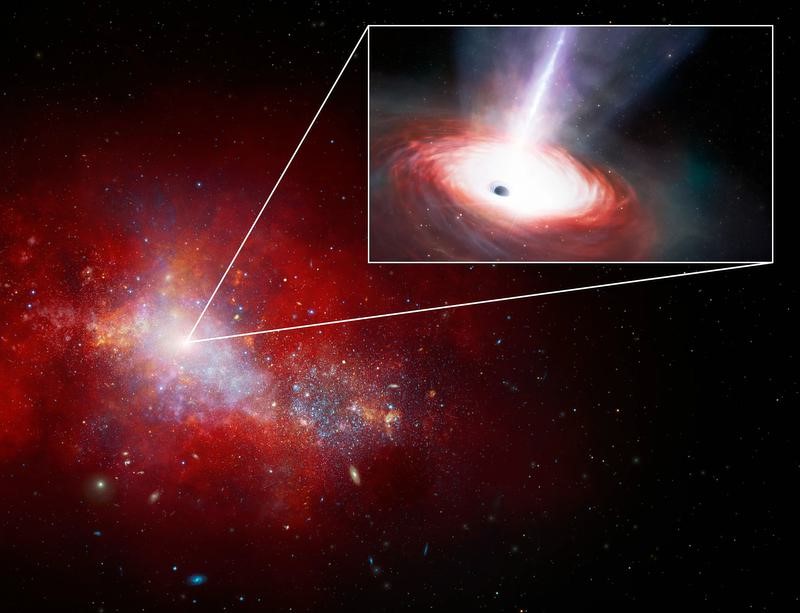
- 23 Jan 2025
In News:
In 2024, an international team of astronomers using NASA’s James Webb Space Telescope (JWST) and the Chandra X-ray Observatory discovered a low-mass supermassive black hole, LID-568, showing super-Eddington accretion—a rare and extreme feeding process—just 1.5 billion years after the Big Bang.
About LID-568
Feature Description
Type Low-mass supermassive black hole
Age Formed ~1.5 billion years after Big Bang (Universe’s “youth”)
Discovery Observed via Chandra (X-ray) & JWST (infrared)
Location In a distant galaxy with very low star formation
Feeding Rate Accreting at ~40× the Eddington limit (super-Eddington accretion)
Key Concepts
Eddington Limit
- Theoretical upper limit on how fast matter can fall into a black hole before radiation pressure balances gravitational pull.
- Exceeding this limit (super-Eddington) is thought to be unstable and short-lived.
Super-Eddington Accretion
- Observed in LID-568, feeding at 40× Eddington rate.
- Suggests rapid, short bursts of black hole growth, not the slow, steady model previously assumed.
Why is LID-568 Important?
Challenges Current Theories
- Traditional black hole growth models require:
- Long periods (hundreds of millions of years).
- Seed black holes formed from:
- Death of first stars (light seeds: 10–100 solar masses).
- Collapse of primordial gas clouds (heavy seeds: 1,000–100,000 solar masses).
- LID-568 suggests brief, intense growth spurts could create supermassive black holes faster than previously thought.
Impact on Host Galaxy
- Powerful outflows prevent gas accumulation → suppresses star formation.
- Indicates black holes can regulate galaxy evolution, even when young.
Scramjet & Hypersonic Technology
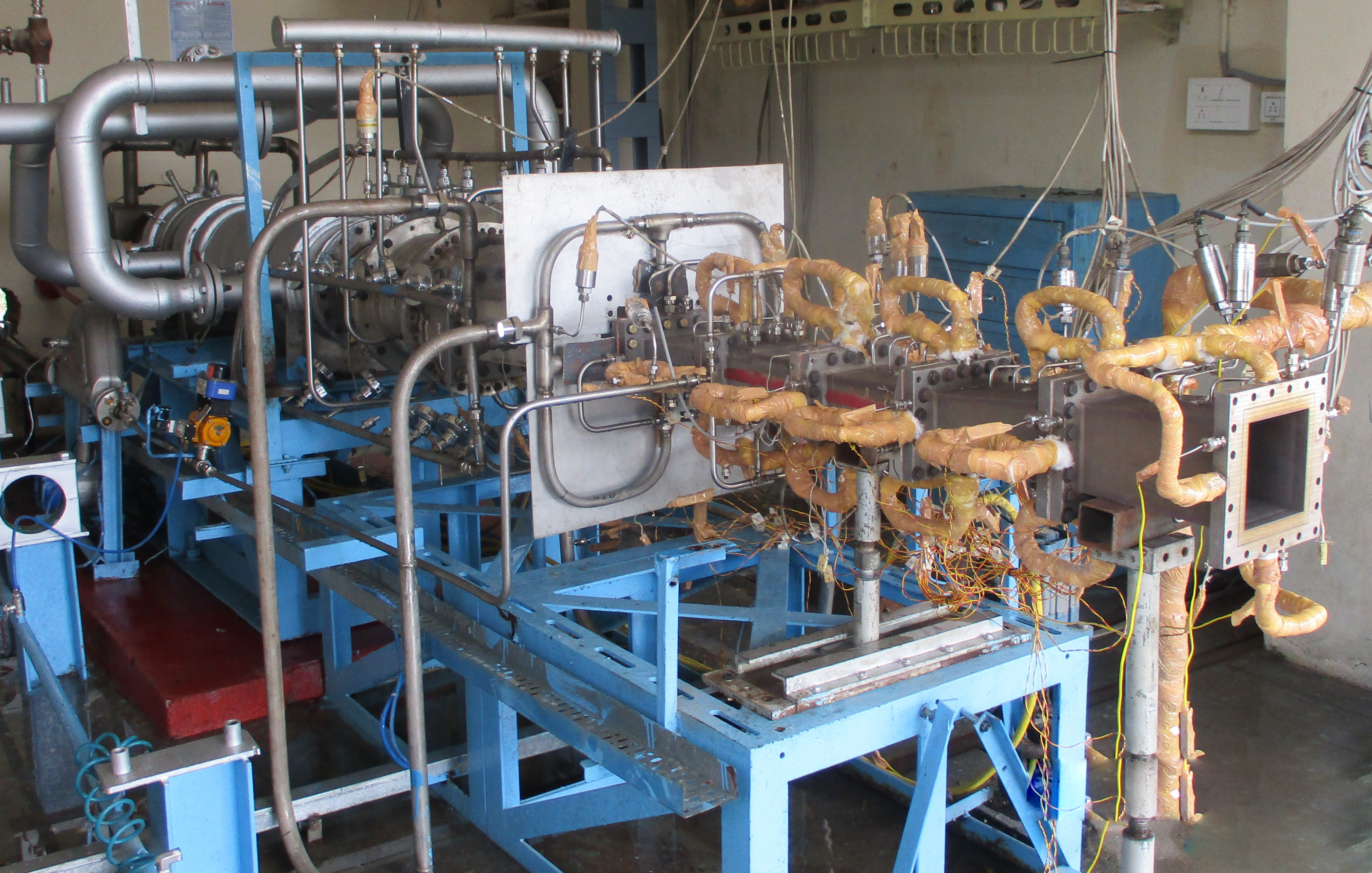
- 23 Jan 2025
In News:
On 21 January 2025, DRDO’s Defence Research & Development Laboratory (DRDL) successfully conducted a 120-second ground test of an indigenously developed Scramjet (Supersonic Combustion Ramjet) engine, marking a major milestone in India’s journey towards hypersonic missile technology.
What is Scramjet Technology?
Definition
A Scramjet is an air-breathing engine that sustains combustion at supersonic speeds—optimized for speeds above Mach 5 (hypersonic range).
Working Principle
- Utilizes vehicle’s forward motion to compress incoming air—no onboard oxidizer needed.
- Injects fuel into the compressed supersonic airflow → ignition → high-speed thrust.
- Operates without moving parts, making it lightweight, efficient, and reliable.
Key Indigenous Innovations
Feature Description
Active-Cooled Combustor Stable combustion achieved at 1.5 km/s airflow, comparable to "keeping a candle lit in a hurricane."
Endothermic Scramjet Fuel First-time development in India; offers cooling + ignition efficiency.
Thermal Barrier Coating (TBC) Jointly developed with DST; withstands temperatures beyond melting point of steel using advanced ceramic coating.
CFD Simulations Used for design optimization and performance validation of flame-holding techniques.
Significance of Scramjet Test
- Stable Combustion: A major challenge in hypersonic propulsion, now successfully demonstrated.
- Hypersonic Missiles:
- Speeds >Mach 5 (~5400 km/h).
- Bypass air defence systems due to speed and maneuverability.
- Enable rapid, high-impact delivery.
- Reusable Launch Vehicles:
- Cuts satellite launch costs via air-breathing propulsion.
- Strategic Edge:
- India joins elite group: USA, Russia, China.
- Strengthens defence deterrence & technological sovereignty.
- Technology Spillover: Advancements in CFD, materials science, flame stabilization, and fuel chemistry.
Global Hypersonic Race
- China (2021): Tested nuclear-capable hypersonic glide vehicle (HGV) that orbited Earth before hitting target.
- USA & Russia: Advanced programs with operational hypersonic systems (e.g., Avangard, Zircon, ARRW).
- India: Now developing indigenous hypersonic missile platform.
Scramjet & Hypersonic Technology

- 23 Jan 2025
In News:
On 21 January 2025, DRDO’s Defence Research & Development Laboratory (DRDL) successfully conducted a 120-second ground test of an indigenously developed Scramjet (Supersonic Combustion Ramjet) engine, marking a major milestone in India’s journey towards hypersonic missile technology.
What is Scramjet Technology?
Definition
A Scramjet is an air-breathing engine that sustains combustion at supersonic speeds—optimized for speeds above Mach 5 (hypersonic range).
Working Principle
- Utilizes vehicle’s forward motion to compress incoming air—no onboard oxidizer needed.
- Injects fuel into the compressed supersonic airflow → ignition → high-speed thrust.
- Operates without moving parts, making it lightweight, efficient, and reliable.
Key Indigenous Innovations
Feature Description
Active-Cooled Combustor Stable combustion achieved at 1.5 km/s airflow, comparable to "keeping a candle lit in a hurricane."
Endothermic Scramjet Fuel First-time development in India; offers cooling + ignition efficiency.
Thermal Barrier Coating (TBC) Jointly developed with DST; withstands temperatures beyond melting point of steel using advanced ceramic coating.
CFD Simulations Used for design optimization and performance validation of flame-holding techniques.
Significance of Scramjet Test
- Stable Combustion: A major challenge in hypersonic propulsion, now successfully demonstrated.
- Hypersonic Missiles:
- Speeds >Mach 5 (~5400 km/h).
- Bypass air defence systems due to speed and maneuverability.
- Enable rapid, high-impact delivery.
- Reusable Launch Vehicles:
- Cuts satellite launch costs via air-breathing propulsion.
- Strategic Edge:
- India joins elite group: USA, Russia, China.
- Strengthens defence deterrence & technological sovereignty.
- Technology Spillover: Advancements in CFD, materials science, flame stabilization, and fuel chemistry.
Global Hypersonic Race
- China (2021): Tested nuclear-capable hypersonic glide vehicle (HGV) that orbited Earth before hitting target.
- USA & Russia: Advanced programs with operational hypersonic systems (e.g., Avangard, Zircon, ARRW).
- India: Now developing indigenous hypersonic missile platform.
10 years of Beti Bachao Beti Padhao (BBBP)
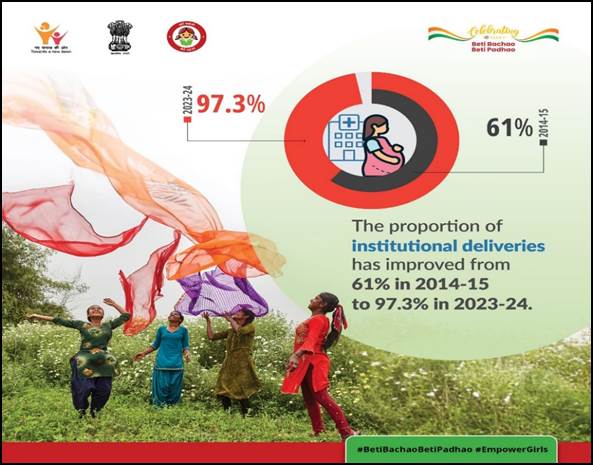
- 23 Jan 2025
In News:
Launched on 22nd January 2015 in Panipat, Haryana, BBBP was initiated in response to the declining Child Sex Ratio (CSR), which stood at 918 girls per 1000 boys (Census 2011). It marked a key step towards gender equality, aiming to curb gender-biased sex-selective elimination and improve the status of the girl child.
Key Highlights:
Core Objectives
- Improve Sex Ratio at Birth (SRB) by two points annually.
- Sustain institutional delivery rate at ≥95%.
- Increase 1st trimester ANC registration and girls' enrollment in secondary education by 1% annually.
- Reduce dropout rates among girls.
- Promote safe menstrual hygiene management (MHM).
Target Groups
- Primary: Young couples, expecting parents, adolescents, households, communities.
- Secondary: Schools, AWCs, health professionals, PRIs, ULBs, NGOs, SHGs, media, and religious leaders.
Implementation Structure
- Type: Centrally Sponsored Scheme (CSS) with 100% Central funding.
- Ministries Involved:
- Women and Child Development
- Health and Family Welfare
- Education
- Financial Assistance (Per District/Year):
- Rs. 40 lakh (SRB ≤918)
- Rs. 30 lakh (SRB 919–952)
- Rs. 20 lakh (SRB >952)
Integration with Mission Shakti (2021–2026)
BBBP now functions under Mission Shakti, which comprises two verticals:
- Sambal (Safety & Security):
- One Stop Centres (OSCs)
- Women Helpline (181)
- Nari Adalat: Alternative dispute resolution
- Samarthya (Empowerment):
- Sakhi Niwas, Palna Creches
- Shakti Sadans (rehabilitation)
- PM Matru Vandana Yojana: Extended support for a second girl child
- SANKALP-HEW: District-level single-window system for all women-centric schemes
Achievements in 10 Years (2015–2025)
- SRB: Improved from 918 (2014-15) to 930 (2023-24)
- Girls’ GER: Rose from 75.5% (2014-15) to 78% (2023-24) in secondary education
- Institutional Deliveries: Increased from 61% to 97.3%
- Kanya Shiksha Pravesh Utsav: Re-enrolled over 1 lakh out-of-school girls
- Economic Empowerment: Integration with skilling initiatives and 70% of PM Mudra loans disbursed to women
- Awareness Campaigns:
- Selfie with Daughter
- Beti Janmotsav
- Yashaswini Bike Expedition
- "Betiyan Bane Kushal" Skill Conference
Sukanya Samriddhi Yojana (SSY) – A Financial Tool for Empowerment
Launched under BBBP, SSY is a small savings scheme to ensure the financial security of girl children.
Key Features
- Eligibility: Indian girl child below 10 years.
- Account: Max 2 per family (exceptions for twins/triplets).
- Deposit Limit: ?250 to ?1.5 lakh/year (15 years).
- Tenure: Account matures 21 years after opening.
- Withdrawals: Up to 50% for higher education after 18 years.
- Tax Benefits: Exempt under Section 80C (EEE status).
Impact
- Over 4.1 crore accounts opened by Nov 2024.
- Promotes long-term savings and financial inclusion.
- Complements BBBP by addressing economic empowerment of girls.
Mission Vatsalya
- Formerly ICPS (2009), then Child Protection Services (2017).
- Merged into Mission Vatsalya in 2021.
- Focuses on:
- Juvenile justice
- Child protection
- Advocacy and rehabilitation
- Ensures “no child is left behind” principle aligned with SDGs.
Pradhan Mantri Matru Vandana Yojana (PMMVY)
- Supports pregnant and lactating mothers:
- ?5,000 in 3 installments + ?1,000 (JSY)
- Now extended to second girl child to promote gender equity.
Targets wage compensation, safe delivery, maternal nutrition, and reduced MMR/IMR.
